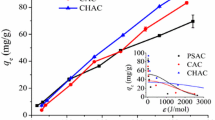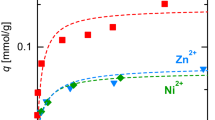Abstract
The ammonia-free thiosulfate extraction of silver can produce silver-copper polymetallic thiosulfate complex in leaching solution. Advanced processes for the recovery of silver in the leaching solution include adsorption, resin, or solvent extraction processes. In this work, the ability of powdered activated carbon (PAC) to adsorb silver in the ammonia-free thiosulfate solution was systematically studied at varying PAC mass (0.5–2.5 g), pH (6.04–11.66), silver concentration (500–1000 mg/L), thiosulfate concentration (0.01–0.1 mol/L), coexisting copper concentration (0–300 mg/L), temperature (298–318 K), and adsorption time (0–360 min). The adsorbent was well characterised by X-ray photoelectron spectroscopy (XPS). The results indicate that more than 92% of Ag(I) could be recovered over a wide pH range, and the adsorption capacity increased with adsorption temperature, reaching a maximum of 42 mg/g-PAC. Analysis of the adsorption isotherm and kinetics parameters indicate that the adsorption of Ag(I) on PAC is with Freundlich isotherm, and the adsorption follows pseudo-second order kinetics.













Similar content being viewed by others
REFERENCES
Renzo, E.P., Chuan, H., Melissa, J., Karinna, V., Humberto, C., Andrew, V.T., and Juan, C.R., Acidic pretreatment of a copper-silver ore and its beneficial effect on cyanide leaching, Miner. Eng., 2020, vol. 149, article no. 106233, pp. 1–8.
Feng, X. and David, B.D., Leaching of silver sulfide with ferricyanide–cyanide solution, Hydrometallurgy, 2007, vol. 88, pp. 98–108.
Hao, J., Feng, X., and David, B.D., Comparative study of auxiliary oxidants in cyanidation of silver sulfide, Hydrometallurgy, 2015, vol. 158, pp. 149–156.
Jeffrey, M.I., Kinetic aspects of gold and silver leaching in ammonia-thiosulfate solutions, Hydrometallurgy, 2001, vol. 60, pp. 7–16.
Aylmore, M.G. and Muir, D.M., Thiosulfate leaching of gold—A review, Miner. Eng., 2001, vol. 14, pp. 135–174.
Jian, W., Wei, W., Kaiwei, D., Yan, F., and Feng, X., Research on leaching of carbonaceous gold ore with copper–ammonia–thiosulfate solutions, Miner. Eng., 2019, vol. 137, pp. 232–240.
Baron, J.Y., Choi, Y., and Jeffrey, M., Double-refractory carbonaceous sulfidic gold ores, chap. 50 of Gold Ore Processing, Elsevier, 2016, pp. 909–918.
Bin, X., Ke, L., and Zhonglin, D., Eco-friendly and economical gold extraction by nickel catalyzed ammoniacal thiosulfate leaching-resin adsorption recovery, J. Cleaner Prod., 2019, vol. 233, pp. 1475–1485.
Jian, W., Feng, X., and Wei, W., Eco-friendly leaching of gold from a carbonaceous gold concentrate in copper–citrate–thiosulfate solutions, Hydrometallurgy, 2020, vol. 191, article no. 105204.
Sitando, O., Senanayake, G., Dai, X., Nikoloski, A.N., and Breuer, P., A review of factors affecting gold leaching in non-ammoniacal thiosulfate solutions including degradation and in-situ generation of thiosulfate, Hydrometallurgy, 2018, vol. 178, pp. 151–175.
Muir, D.M. and Aylmore, M.G., Thiosulphate as an alternative to cyanide for gold processing-issues and impediments, Trans. Inst. Min. Metall., Sect. C, 2004, vol. 113, no. 1, pp. 2–12.
Cui, Y.Q., Xiong, T., and Alejandro, L., Silver sulfide leaching with a copper-thiosulfate solution in the absence of ammonia, Rare Met., 2011, vol. 30, no. 2, pp. 105–109.
Chao, H., Wei, W., and Feng, X., Study on the leaching of mercuric oxide with thiosulfate solutions, Metals, 2016, vol. 6, no. 9, p. 206.
Chao, H., Wei, W., Feng, X., and Ting’an, Z., Mechanism and kinetics of mercuric sulfide leaching with cuprous-thiosulfate solutions, Sep. Purif. Technol., 2017, vol. 177, pp. 223–232.
Chao, H., Hui, W., Feng, X., Wei, W., Ting’an, Z., and David, D., Feasibility study on the use of thiosulfate to remediate mercury-contaminated soil, Environ. Technol., 2019, vol. 40, no. 7, pp. 813–821.
Chao, H., Wei, W., Feng, X., Guangxin, W., Alex, V., and Moses, G., Study on pure mercurous chloride leaching with sodium thiosulfate, Russ. J. Non-Ferrous Met., 2018, vol. 59, no. 6, pp. 589–595.
Patricio, N., Cristian, V., Manuel, A., and Francisco, J.A., Towards a more environmentally friendly process for gold: models on gold adsorption onto activated carbon from ammoniacal thiosulfate solutions, Desalination, 2007, vol. 211, nos. 1–3, pp. 58–63.
Zhang, X.Z., Adsorption of precious and base metal thiosulfate complexes on activated carbon, MSc Thesis, Shenyang: Northeastern Univ., 2015.
Nielsen, L., Biggs, M.J., Skinner, W., and Bandosz, T.J., The effects of activated carbon surface features on the reactive adsorption of carbamazepine and sulfamethoxazole, Carbon, 2014, vol. 80, pp. 419–432.
Yunlong, C., Futing, Z., Xianzhi, H., Peng, Y., Yongping, M., Huiling, C., Qiang, W., Xuecong, Q., Yang, L., Shuliang, C., and Chaowu, W., The use of new modified activated carbon in thiosulfate solution: A green gold recovery technology, Sep. Purif. Technol., 2020, vol. 230, article no. 115834.
Biniak, S., Szymański, G., Siedlewski, J., and Tkowski, A.Ś.J.M., The characterization of activated carbons with oxygen and nitrogen surface groups, Carbon, 1997, vol. 35, pp. 1799–1810.
Macías-García, A., Valenzuela-Calahorro, C., Gómez-Serrano, V., and Espínosa-Mansilla, A., Adsorption of Pb2+ by heat-treated and sulfurized activated carbon, Carbon, 1993, vol. 31, pp. 1249–1255.
Gheju, M. and Miulescu, A., Sorption equilibrium of hexavalent chromium on granular activated carbon, Chem. Bull. “Politeh.” Univ. Timisoara, 2007, vol. 52 (66), nos. 1–2, pp. 41–46.
Jin, Q., Mengmeng, S., Peifang, W., Chao, W., Kun, L., Jingjing, L., Bianhe, L., and Xin, T., Perfluorooctane sulfonate adsorption on powder activated carbon: Effect of phosphate (P) competition, pH, and temperature, Chemosphere, 2017, vol. 182, pp. 215–222.
Hammond, J.S., Holubka, J.W., DeVries, J.E., and Dickie, R.A., The application of x-ray photo-electron spectroscopy to a study of interfacial composition in corrosion-induced paint de-adhesion, Corros. Sci., 1981, vol. 21, no. 3, pp. 239–253.
Jordan, R.G., Liu, Y., and Qiu, S.L., The origin of short-range order in Ag-Mg alloys, Acta Metall. Mater., 1994, vol. 42, no. 10, pp. 3535–3538.
Wagner, C.D., Chemical shifts of Auger lines and the Auger parameter, Faraday Discuss. Chem. Soc., 1975, vol. 60, no. 60, pp. 291–300.
Peisert, H., Chassé, T., Streubel, P., Meisel, A., and Szargan, R., Relaxation energies in XPS and XAES of solid sulfur compounds, J. Electron Spectrosc. Relat. Phenom., 1994, vol. 68, pp. 321–328.
Wu, M.C., Dong, S.Z., and Zhu, A.R., Studies of CO dissociation promoted by Na on Ag(110), Surf. Sci., 1989, vol. 216, no. 3, pp. 420–428.
Hegde, M.S. and Ayyoob, M., O2- and O1- types of oxygen species on Ni and barium-dosed Ni and Cu surfaces, Surf. Sci., 1986, vol. 173, nos. 2–3, pp. L635–L640.
Bukhtiyarov, V.I., Kondratenko, V.A., and Boronin, A.I., Features of the interaction of a CO+O2 mixture with silver under high pressure, Surf. Sci., 1993, vol. 293, nos. 1–2, pp. 826–829.
Li, X., Zhang, Y., Jing, L., and He, X., Novel N-doped CNTs stabilized Cu2O nanoparticles as adsorbent for enhancing removal of Malachite Green and tetrabromobisphenol A, Chem. Eng. J., 2016, vol. 292, pp. 326–339.
Chaowu, W., Shuliang, C., Yunlong, C., Futing, Z., Xianzhi, H., Xuecong, Q., Yan, Z., Peng, Y., Yi, H., Puqiang, H., Yue, L., and Guifen, Z., Modification of activated carbon by chemical vapour deposition through thermal decomposition of thiourea for enhanced adsorption of gold thiosulfate complex, Sep. Purif. Technol., 2020, vol. 241, article no. 116632.
ACKNOWLEDGMENTS
This work was supported by Doctoral Scientific Research Foundation of Henan University of Science and Technology (Grant no. 400213480089), Postdoctoral Scientific Research Foundation of Henan University of Science and Technology (Grant no. 400213554022) and The Key Scientific Research Project of Colleges and Universities in Henan Province (Grant no. 21A450001).
Author information
Authors and Affiliations
Corresponding author
Ethics declarations
The authors declare that they have no conflict of interest.
About this article
Cite this article
Han, C., Li, J., Wang, G. et al. The Adsorption of Silver on Powdered Activated Carbon in the Ammonia-Free Thiosulfate Leaching Solution. Russ. J. Non-ferrous Metals 62, 165–173 (2021). https://doi.org/10.3103/S1067821221020061
Received:
Revised:
Accepted:
Published:
Issue Date:
DOI: https://doi.org/10.3103/S1067821221020061




